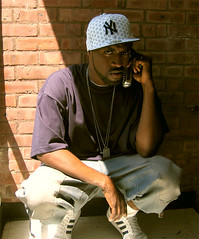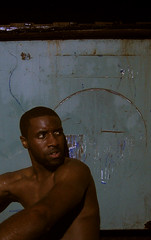Flashback: Honoring the Sacred 03.16.02

Detail view of the architecture of a window in Notre Dame Cathedral in Paris.
The Notre-Dame Cathedral in Paris, erected between 1163-1345, is one of the most frequently referenced monuments of the gothic era. The stained glass, intricate woodwork, the lifelike Biblical figures and latter day saints are the epitome of gothic perfection. Visiting this sacred place was an interesting experience for several reasons… Being someone who has abandoned traditional ways of approaching the spiritual and enacting "religion," there will always be a bit of tension when approaching any monument with such an overwhelming religious overtone.
At an earlier time in my evolution, I would have attempted to comment only on the architectural value of the cathedral, reasoning that my heterodox position rendered its persona altogether inaccessible to me. Nowadays, however, I recognize but also interrogate the tension that exists. How does the Judeo-Christian tradition attempt to affirm its followers and discourage others? How do sacred relics and figures (the crucifix, the Virgin Mary) attempt to authenticate and define a spiritual tradition and simultaneously embody its precepts? What is alienating about my experience of observing their sacred practices?
What was most interesting to me was the dual function of the church. Not only was it a historicized site for communing with fellow believers, receiving the Word of God, and affirming one’s beliefs; it was equally invested in its role in Parisian tourism. Imagine this: there is a mass going on in the center of the cathedral – hundreds of people [appearing to be] engaged in the religious service. Meanwhile, hundreds more tourists circle about the outskirts of the mass, noisily taking snapshots… pointing, appraising, and wandering about with a wanton and haphazard disregard for the sacred.

For two Euros, (Europe’s new standard currency) they may light prayer candles or cross the velvet rope to kneel at the prayer-only pew. No signs instruct them to remain silent or abstain from flash photography during the service. Rather, the circle through the perimeter of the cathedral ends at the church's quaint (but seemingly inappropriate) gift shop. Suddenly, the domain of the sacred is commodified and the religious experience is grotesquely reduced to consumable trinkets of the marketplace.
The sound system is installed smartly, to overpower the too-loud conversations and carelessly irreverent footsteps of tourists. And I think there must have been a time earlier in the cathedral’s project to fuse religion and tourism when the priest was annoyed with the constant camera flashes or the unceasing drumming feet of non-believers during moments of silence.
And I wonder if I was to erect sacred place of worship to accommodate the community of heterodox spirit-led people… what rules would we adopt and which would we abandon? No non-believers allowed? No exchange of goods or services allowed? And how similar are these rule to those governing the sacred places of worship in biblical times? Hmmm… Did the high priests, pharaohs and Sadducees have things figured out, or are there more appropriate ways to go about creating the sacred?




1 Comments:
I have been to Norte-Dame a few times (most recently a few weeks ago). It always surprises me that there is mass going on, and the visitors are just walking around taking pictures...there is even a gift shop in the church.
I questioned one of the staff members about it, and they told me that they welcome everyone, visitors and worshippers alike, plus the funds are used for the upkeep of the building and grounds.
Post a Comment
<< Home